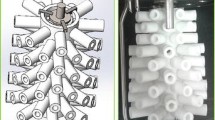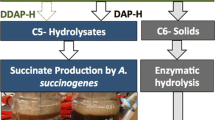Abstract
Succinic acid, a four-carbon diacid, has been the focus of many research projects aimed at developing more economically viable methods of fermenting sugar-containing natural materials. Succinic acid fermentation processes also consume CO2, thereby potentially contributing to reductions in CO2 emissions. Succinic acid could also become a commodity used as an intermediate in the chemical synthesis and manufacture of synthetic resins and biodegradable polymers. Much attention has been given recently to the use of microorganisms to produce succinic acid as an alternative to chemical synthesis. We have attempted to maximize succinic acid production by Actinobacillus succinogenes using an experimental design methodology for optimizing the concentrations of the medium components. The first experiment consisted of a 24−1 fractional factorial design, and the second entailed a Central Composite Rotational Design so as to achieve optimal conditions. The optimal concentrations of nutrients predicted by the model were: NaHCO3, 10.0 g l−1; MgSO4, 3.0 g l−1; yeast extract, 2.0 g l−1; KH2PO4. 5.0 g l−1; these were experimentally validated. Under the best conversion conditions, as determined by statistical analysis, the production of succinic acid was carried out in an instrumented bioreactor using sugarcane bagasse hemicellulose hydrolysate, yielding a concentration of 22.5 g l−1.






Similar content being viewed by others
References
Agarwal L, Isar J, Meghwanshi GK, Saxena RK (2006) A cost effective fermentative production of succinic acid from cane molasses and corn steep liquor by Escherichia coli. J Appl Microbiol 100(6):1348–1354
Banik RM, Santhiagu A, Upadhyay SN (2007) Optimization nutrients for gellan gum production by Sphingomonas paucimobilis ATCC-31461 in molasses based medium response surface methodology. Bioresour Technol 98(4):792–797
Bechthold I, Bretz K, Kabasci S, Kopitzky R, Springer A (2008) Succinic acid: a new platform chemical for biobased polymers from renewable resources. Chem Eng Technol 31(5):647–654
Betancur GV, Pereira Jr N (2010) sugarcane bagasse as feedstock for second generation ethanol production. Part I: diluted acid pre-treatment optimization. Electron J Biotechnol. Available at: http://www.ejbiotechnology.info/content/vol13/issue3/full/3/
Box GEP, Hunter WG, Hunter JS (1978) Statistics for experimenters: an introduction to design data analysis and model building. Wiley, New York
Du CY, Carol Lin SK, Koutinas A, Wang RH, Dorado P, Webb C (2008) A wheat biorefining strategy based on solid-state fermentation for fermentative production of succinic acid. Bioresour Technol 99(17):8310–8315
Fogel R, Garcia RR, Oliveira SR, Palacio D, Madeira L, Pereira N (2005) Optimization of acid hydrolysis of sugarcane bagasse and invetigations on its fermetability for production of xylitol by Candida guilliermondii. Appl Biochem Biotechnol 122(1–3):741–752
Gluettler MV, Rumler D, Jain MK (1999) Actinobacillus succinogenes sp. nov., a novel succinic acid producing strain from the bovine rumen. Int J Syst Bacteriol 49:207–216
Huh YS, Jun Y-S, Kong YK, Song H, Lee SY, Hong WH (2006) Effective purification of succinic acid from fermentation broth produced by Mannheimia succiniciproducens. Process Biochem 41(6):1461–1465
Kim DY, Yim SC, Lee PC, Lee WG, Lee SY, Chang HN (2004) Batch and continuous fermentation of succinic acid from wood hydrolyzate by Mannheimia succiniciproducens MBEL55E. Enzyme Microb Technol 34(6–7):648–653
Lavarack BP, Griffin GJ, Rodman D (2002) The acid hydrolysis of sugarcane bagasse hemicellulose to produce xylose, arabinose, glucose and other products. Biomass Bioenergy 23(5):367–380
Lee PC, Lee WG, Kwon S, Lee SY, Chang HN (1999) Succinic acid production by Anaerobiospirillum succiniciproducens: effects of the H2/CO2 supply and glucose concentration. Enzyme Microb Technol 24(8–9):549–554
Lee PC, Lee SY, Hong SH, Chang HN (2002) Isolation and characterization of new succinic acid producing bacterium Manheimia succiniciproducens MBEL 55E, from bovine rumen. Appl Microbiol Biotechnol 21(4):663–668
Lee PC, Lee SY, Hong SH, Chang HN, Park SC (2003) Biological conversion of wood hydrolyzate to succinic acid by Anaerobiospirillum succiniciproducens. Biotechnol Lett 25(2):111–114
Lin H, Bennet GN, San KY (2005) Fed-batch culture of a metabolically engineered Escherichia coli strain designed for high-level succinate production and yield under aerobic conditions. Biotechnol Bioeng 90(6):775–779
Liu YP, Zheng P, Sun ZH, Ni Y, Dong JJ, Zhu LL (2008) Economical succinic acid production from cane molasses by Actinobacillus succinogenes. Bioresour Technol 99(6):1736–1742
Lynd LR, Wyman CE, Gerngross TU (1999) Biocommodity engineering. Biotechnol Prog 15(5):777–793
Meynial-Salles I, Dorotyn S, Soucaille P (2008) A new process for the continuous production of succinic acid from glucose at high yield, titer and productivity. Biotechnol Bioeng 99(1):129–135
Okuda N, Ninomiya K, Takao M, Katakura Y, Shioya S (2007) Microaeration enhances productivity of bioethanol from hydrolyzate of waste house wood using ethanologenic Escherichia coli KO11. J Biosci Bioeng 103(4):350–357
Papanikolaou S, Sarantou S, Komaitis M, Aggelis G (2004) Repression of reserve lipid turnover in Cunninghamella echinulata and Mortierella isabellina cultivated in multiple-limited media. J Appl Microbiol 97(4):867–875
Pereira N, Couto MAPG, Santa Anna LM (2008) Series on biotechnology: biomass of lignocellulosic composition for fuel ethanol production within the context of biorefinery. Amigadigital Press, Rio de Janeiro
Rudner MS, Jeremic S, Petterson KA, Kent DR, Brown KA, Drake MD, Goddard WA, Roberts JD (2005) Intramolecular hydrogen bonding in disubstituted ethanes. A comparison of NH…O− and OH…O− hydrogen bonding through conformational analysis of 4-amino-4-oxobutanoate (succinamate) and monohydrogen 1,4-butanoate (monohydrogen succinate) anions. J Phys Chem A 109(40):9076–9082
Sauer M, Porro D, Mattanovich D, Branduardi P (2008) Microbial production of organic acids: expanding the markets. Trends Biotechnol 6(2):100–108
Song H, Lee JW, Choi S, You JK, Hong WH, Lee SY (2007) Effects of dissolved CO2 levels on the growth of Mannheimia succiniciproducens and succinic acid production. Biotechnol Bioeng 98(6):1296–1304
Urbance SE, Pometto AL III, Di Spirito AA, Demirci A (2003) Medium evaluation and plastic composite support ingredient selection for biofilm formation and succinic acid production by Actinobacillus succinogenes. Food Biotechnol 17(1):53–65
van der Werf MJ, Guettler MV, Jain MK, Zeikus JG (1997) Environmental and physiological factors affecting the succinate product ratio during carbohydrate fermentation by Actinobacillus sp. 130Z. Arch Microbiol 167(6):332–342
Vemuri GN, Eiteman MA, Altman E (2002) Succinate production in dual-phase Escherichia coli fermentations depends on the time of transition from aerobic to anaerobic conditions. J Ind Microbiol Biotechnol 28(6):325–332
Wyman CE, Dale BE, Elander RT, Holtzapple M, Ladisch MR, Lee YY (2005) Coordinated development of leading biomass pretreatment technologies. Bioresour Technol 96(18):1959–1966
Zeikus JG, Jain MK, Elankovan P (1999) Biotechnology of succinic acid production and markets for derived industrial products. Appl Microbiol Biotechnol 51(5):545–552
Zheng P, Dong JJ, Sun ZH, Ni Y, Fang L (2009) Fermentative production of succinic acid from straw hydrolysate by Actinobacillus succinogenes. Bioresour Technol 100(8):2425–2429
Acknowledgments
The authors are grateful to the Brazilian Council for Research (CNPq); the Rio de Janeiro Foundation for Science and Technology (FAPERJ) and the Brazilian Oil Company (PETROBRAS) for financial support of this research.
Author information
Authors and Affiliations
Corresponding author
Electronic supplementary material
Below is the link to the electronic supplementary material.
Rights and permissions
About this article
Cite this article
Borges, E.R., Pereira, N. Succinic acid production from sugarcane bagasse hemicellulose hydrolysate by Actinobacillus succinogenes . J Ind Microbiol Biotechnol 38, 1001–1011 (2011). https://doi.org/10.1007/s10295-010-0874-7
Received:
Accepted:
Published:
Issue Date:
DOI: https://doi.org/10.1007/s10295-010-0874-7




